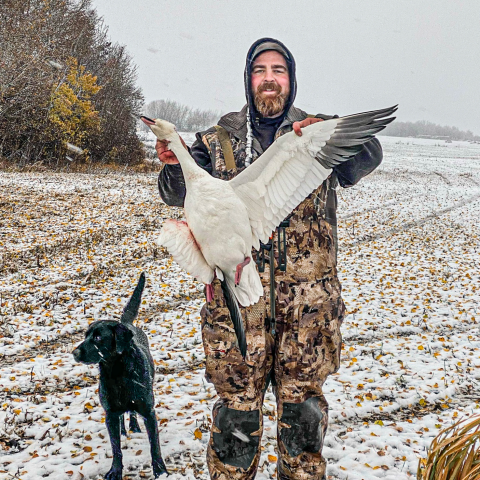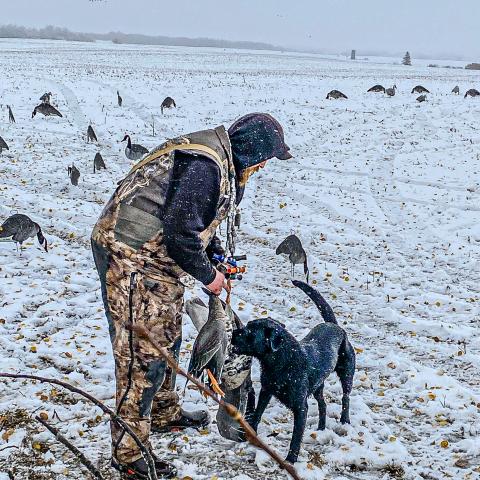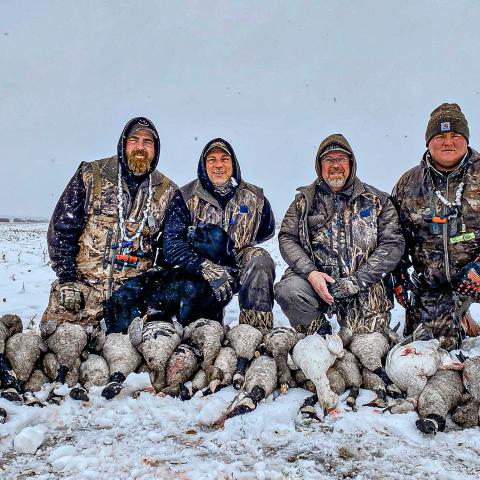Whiteout Waterfowl
The alarm went off, and I enthusiastically jumped out of bed to embrace the morning ahead. It reminded me of going hunting when I was a kid and not being able to sleep the night before a hunt. I would ask my dad every hour if it was time to get up, and he would emphatically tell me to get back to bed until the alarm sounded.
There was a certain silence to the morning that seemed odd. I got dressed and walked into the main lodge at Saskatchewan Goose Company to find my buddy Mario Friendy and the outfitter, Tyler Mann, talking by the coffee pot. I asked, “why such a quiet morning, and where is everyone else?”
Tyler grew a big smirk and told me to look out the front door. To my astonishment, there was a foot of fresh snow on the ground, still coming down like a white blanket falling from the sky. The heavy, wet snow created an eerie silence. Tyler indicated that the other hunters were staying in bed. I looked at the only two guys as crazy as me and asked, “are we still going?”
It was October 15th and the first significant snowfall of the year. The highway was a white ridge with no lines or hardtop visible. It was snowing hard, and we slowly made it to the field where we had watched thousands of ducks and geese the previous day. We knew the birds would still be in the country and would likely come late to the field. The drive to the field created white knuckles from the stiff grip on the steering wheel and manueuvering on the icy roadways.
We set up blinds and put snow covers over the frames. We scurried through the field, creating trails that looked like spiderwebs capturing our decoys. The wind was brisk, and the snow stung our checks when we faced the blustery squall. Decoys were strategically placed, and we huddled in the back of the decoy trailer to stay warm and dry as we waited for daylight. We giggled and laughed about the weather and challenging conditions. The shoot would either be a bust or a banger, and we laid all our cards on the table; beating it would be incredible. The trailer was temporary comfort before the games were to begin. We watched the trailer lights create a kaleidoscope effect with swirling snowflakes lit up in a tornado of activity.
The eastern sky brightened, but the snow kept the horizon dull. After sunrise, the first flock of lessers spun over the far end of the field and headed in our direction. The birds made a beeline for our decoys tucked along the edge of the field. Unfortunately, we were greeted with an unfavorable fowl reception, and the birds flared hard off our blinds. We wasted no time making a change, moving our hide closer to the trees, and cutting some branches to stack along the front edge of the snow covers. We had to move decoys, but they needed a shake and rub to clear the snow off one side, making a dual-purpose effort. The conditions were a severe test for gear to keep warm and dry.
We no sooner got situated back in the blind when a mixed flock of lessers, specks, and snows lined up and fought the wind to get with the birds already on the ground. Big adult specks with tar bellies looked dark and ominous, making them easy to watch and track. Shotguns erupted, and birds rained down into the decoys. The remainder of the flock escaped in seconds by opening their wings and grabbing some wind. The flock we shot at disappeared into the snow-filled sky as the next flock worked toward our calls from the far end of the field. The birds seemed to take forever to get within range, fighting the wind and horizontal snow across the field. A couple of big honkers and snows were added to the bag.
We had to run out to clean decoys every 10 minutes, as they quickly turned white as from being peppered with wet snow on a strong wind. The following 30 minutes was a fantastic experience avid waterfowlers dream of experiencing. Flocks of ducks and geese lined the sky; as we shot at one, the next would emerge from the stormy horizion.
Giant flocks of lessers worked the decoys and finished tight. There was no room or extra energy for circling the field before landing, forcing birds to commit fast. We scrambled to reload shotguns, prepare for the next onslaught of birds, and forgot all about the weather. The black lab streaked across the field, retrieving downed birds in stark contrast to his surroundings.
Mallards and pintails started to show up in number, muscling up and soaring towards our decoys. The shooting was fast and furious, with challenging angles and fast fleeing targets—the first shot out of the semi-automatic shotgun needed to count. The following two were faster than targets thrown off an international skeet tower. Birds were milling together, and we made a point of targeting specklebellies when possible. I wondered if the others back in the camp were still sleeping. Perhaps they were enjoying a cup of coffee and laughing about the crazy guys that considered going out in the blizzard-like conditions.
Tyler looked over at me and tapped the snow off the rib of his Super Black Eagle 3. My barrel was hot enough that the snow didn’t accumulate. The sky was getting brighter, and the snow was starting to slow, creating some visibility. We could sense that the accumulation snow was starting to melt and settle, and so could the birds. The waves of geese we had seen when spotting were returning for breakfast, and they were hungry.
Somehow the shooting got even better, and we took turns recording video on our cell phones while the others shot. We completed our limits and reminisced about the incredible morning we shared. You rarely get to hunt a blinding snow squall and have birds desperate to get in for a feed and out of the inhospitable airspace.
We gathered decoys and tried to wipe the moisture off, but they would need airing out back at camp to dry. By the time we left the field, the snow had stopped, and the warm ground quickly ate the snow that accumulated overnight. Birds filled the sky in every direction, letting us know it was prime time, and the weather event was nothing but a blip on the radar. We spotted dozens of potential hunts on the way back to camp. The roads were more challenging, being wet and muddy than snow-covered.
It was time to get back to camp and maybe have a snooze before cleaning birds—alternatively, a cup of coffee and some ribbing for those that did not get out of bed. You need to seek adventure in order to experience it.





